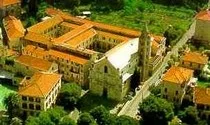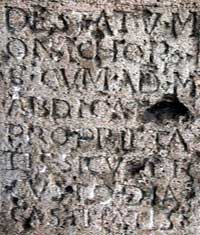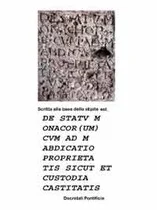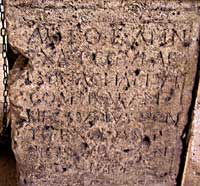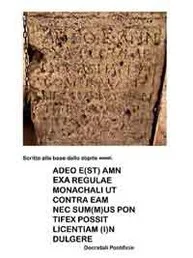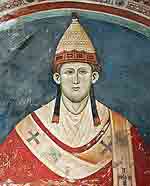two tablets
Documents
PORTAL NORTH SIDE
We have so far talked about side A of the Portal, that side that looks towards the south, that is the one open towards that space open for centuries to the population and which - over time - will later become the First cloister.
Free access to this space was dictated by the people's custom of drawing from a particular well (later eliminated) known for the special goodness of the water vein that was found there.
As they say that one cherry leads to another, so it happened that speaking of side A of the Portal we too ended up letting ourselves be drawn into talking about some particularities of our monastery, which entertained us for a few weeks.
The last topic we were talking about concerned access to the Abbey building from the current Abbey Square.
We will resume it in due time, but now we want to conclude with the B side of the Portal, the one that faces north.
The north side, on the other hand, is exquisitely monastic, because it is reserved for the life of the community of monks and since its origins it has been, in itself, reserved for the monastic enclosure.
Here we no longer find St. Jerome, the Madonna of Pia and St. Benedict.
Much less will we find references to ancient mythology (bull, lion, or even a Fury, complete with snakes for hair), figures often evoked in Renaissance works (our portal dates from 1522, as attested by the date engraved in the 'intrados, which – erroneously – is often read 1577.
Fra' Angelo of Albenga, who had it erected, speaks in his autobiography of the inauguration and blessing of this work which took place in 1522. Incidentally, it should be remembered that Fra' Angelo of Albenga died in 1534 and that it was very difficult for him to participate in a blessing service in 1577.
Instead of mythology, on side B of this portal, two solid epigraph texts appear, in medieval Latin, taken from the Decrees of Innocent III.
In the history of the Church, constitutions of a general nature issued by the popes were called decrees, which, drafted in the form of letters, often contained juridical norms and had obligatory force for all the faithful, except in well-specified cases.
Gathered in three official collections by Popes Gregory IX, Boniface VIII and Clement V, the decrees then became part of the Corpus iuris canonici. In fact, Pope St. Pius X wanted to collect ecclesiastical legislation in a single text (ordinarily known as the Codex Iuris Canonici), but the text was only published in 1917 by Benedict XV and was entitled the Benedictine Plan Code, from the names of the two popes who created it ( Pius X and Benedict XV). The wear and tear of time has made these two epigraph texts of ours almost unreadable, but with a little good will they can be deciphered and (what is more important) to grasp the seriousness and unique splendour of monastic life, which not even a Supreme Pontiff can tamper with, without running the risk of turning it off.
Today we submit to your kind attention the two epigraph texts found at the base of the two jambs of the Portal. We trust that, in the coming weeks, we will find time and space to show you the treasures that Innocent III, in the wake of the monastic tradition, has disseminated (rather than hidden) there.
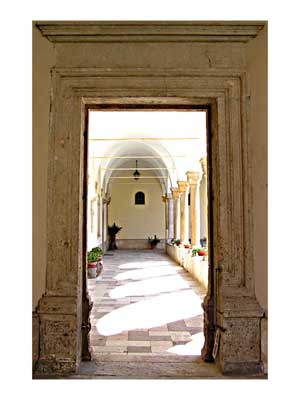
Step by step we have seen the two apparently tangled epigraph texts, which are found at the base of the left (east) and right (west) jambs of the north side of the portal, transform into more easily readable Latin texts.
Those accustomed to seeing the clarity and precision of Egyptian hieroglyphic texts carved over thousands of years into that country's monuments, which in high-definition photographs and video are offered to us in publications and on modern screens, may be disappointed by the crudeness of the our two epigraphs.
But here we are faced with products of completely different cultures and - above all - with the fact that everyone makes fire with the wood they have available.
Finale stone is excellent for many jobs, but not for all.
It is however admirable that, in this case, for 5 centuries it has preserved some traits of our culture.
But what do these Latin texts want to tell us?
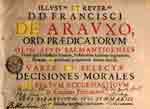 Before continuing with the commentary on these texts, I feel the need to express a heartfelt thanks to P. Abbot Umberto BEDA, who was effectively interested in these texts during his Priory in Finalpia. When I met him at the Sacro Speco of Subiaco in 1999, the then Fr. Beda (not yet Abbot) was Director of the important State Library of the Monastery of Santa Scolastica in Subiaco. It was he, thanks to his professionalism as a competent library director, who retrieved a volume on the internet that contained our two texts, which were therefore more easily read.
Before continuing with the commentary on these texts, I feel the need to express a heartfelt thanks to P. Abbot Umberto BEDA, who was effectively interested in these texts during his Priory in Finalpia. When I met him at the Sacro Speco of Subiaco in 1999, the then Fr. Beda (not yet Abbot) was Director of the important State Library of the Monastery of Santa Scolastica in Subiaco. It was he, thanks to his professionalism as a competent library director, who retrieved a volume on the internet that contained our two texts, which were therefore more easily read.Thanks to Don Beda, not only was the volume we were looking for found but - and always only online - he was also able to identify and consult the pages that interested us.
In fact, the epigraph style of writing, the wear and tear of time and the carelessness of men made, in some points, the exact spelling problematic of the writing reported in the Stone of Finale, with which our Portal was built.
COMPLETED RECONSTRUCTED TEXTS
EPIGRAPH TEXTS USE ARRANGEMENTS IN PARTICULAR ABBREVIATIONS NOT EASY TO READ
1)- DE STATV MONACHOR(UM) CVM AD M(ONACHORUM) ABDICATIO(NEM) PROPRIETATIS SICUT ET CUSTODIA(M) CASTITATIS
2)-ADEO E(ST) ADNEXA REGULAE MONACHALI UT CONTRA EAM NEC SUM(M)US PONTIFEX POSSIT LICENTIAM (I)NDULGERE
*NOTE
-THE TEXT AT THE BASE OF THE EAST SIDE JAMB IN BLUE (on the left)
-IN RED THE TEXT AT THE BASE OF THE WEST SIDE JAMB (on the right)
TRANSLATION
1)-ABOUT THE STATE OF MONKS, WITH REGARD TO THEIR RENOUNCEMENT OF PROPERTY AND THE GUARDING OF CHASTITY.
2)-IT IS SO ANNEX TO THE MONASTIC RULE THAT NOT EVEN THE SUPREME PONTIFF CAN GRANT DISPENSATION FROM IT.
COMMENT
1)- THE RENOUNCEMENT OF PROPERTY AS THE GUARD OF CHASTITY
Quite a few sages and philosophers of our Greek/Roman civilisation renounced ownership of the goods of this world, because they were considered superfluous.
It is known that Diogenes of Sinope (about 412 BC – 323 BC), known as the Cynic (the one famous for having chosen to live in a common barrel) gave up the wooden bowl he used to drink water after noticing a boy who drank it with his hands.
In this Decree, Pope Innocent III is not speaking of matrimonial chastity, but of monastic chastity, which involves total sexual continence.
In the Western world this chastity was not considered a value, much less in the official Jewish world, where prolificacy was indeed honoured, in anticipation of the hoped-for birth of the Messiah.
To see it valued and practised, one would have had to approach the Asian Hindu and Buddhist world.
It is known that Mahatma Gandhi, in agreement with his wife, tried several times to live in chastity, but in vain. By persisting in this purpose they attained the happiness of succeeding in it.
Thus in the renunciation of ownership the Pope also included a commitment on the part of the monk to relinquish the management of his own body, in the words of St. Paul "I therefore urge you, brethren, by the mercy of God, to offer your bodies as a living sacrifice holy and pleasing to God; this is your spiritual worship" (Rom 12:1).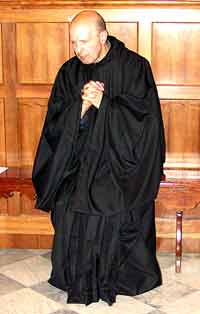

This renunciation makes the monk's commitment shine with a sparkling prophetic light, as can be seen from Jesus' words relating to the final Resurrection: "When they rise from the dead, in fact, they will neither marry nor be given in marriage, but will be like angels in heaven." (Mk 12, 25).
While then St. Paul will reveal to us that true love (Charitas), the one that binds Christians and Christian families in this world, will never end (1Cor 13, 13).
However, it must always be kept in mind that Jesus holds the marriage union in great consideration, as can be seen from his participation in the wedding at Cana, where he increased its joy with the well-known miracle of the excellent wine donated.
2)- IT IS SO ANNEX TO THE MONASTIC RULE THAT NOT EVEN THE SUPREME PONTIFF CAN GRANT DISPENSATION FROM IT.
Here Innocent III reiterates that, for monks and nuns, the renunciation of property also includes monastic chastity, so much so that not even a Pope can dispense.
CONCLUSION
We have finally come to the conclusion of the commentary on the content of the two epigraphs (tablets) found at the base of the two jambs of the north side of the Renaissance Portal (1522), which leads from the First cloister into the Second.
We have resolved the texts written in an epigraphic Latin and worn out by time and human carelessness, bringing them back to an easier to understand Latin and we have revealed the shining treasure they contain.
In order to unveil this treasure we have worked for a few weeks, with corrections, clarifications and second thoughts, as those who have followed us faithfully can ascertain and now we entrust the conclusion of this work to the same words of Innocent III: The renunciation of property as the custody of chastity it is so attached to the monastic rule that not even the Supreme Pontiff can grant a dispensation; so much so that a dispensation on these points – even if granted by a Pope – would risk extinguishing the luminous life of about 2,000 years of our monasticism.
